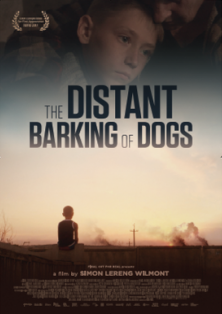The Distant Barking of Dogs (Wilmont, 2017): Denmark
Viewed by Larry Gleeson as part of the 2018 AFI DOCS Film Festival in Washington, D.C.
 The Distant Barking of Dogs, a documentary written, directed and shot by Simon Lereng Wilmont, and produced by Monica Hellstrom, shows a slice of life in an Eastern Ukraine village located within a mile of the front line of the Russian/Ukraine armed conflict in the winter of 2016. The film highlights a year in the life of a ten-year-old boy, Oleg, with a fly-on-the-wall approach, as Oleg becomes desensitized to the fragments of war and, along the way, loses the innocence of childhood. The Distant Barking of Dogs has garnered awards from the 2017 Amsterdam International Documentary Film Festival (First Appearance Award), the DocAviv Film Festival (Best International Film) and the San Francisco International Film Festival (Golden Gate Award).
The Distant Barking of Dogs, a documentary written, directed and shot by Simon Lereng Wilmont, and produced by Monica Hellstrom, shows a slice of life in an Eastern Ukraine village located within a mile of the front line of the Russian/Ukraine armed conflict in the winter of 2016. The film highlights a year in the life of a ten-year-old boy, Oleg, with a fly-on-the-wall approach, as Oleg becomes desensitized to the fragments of war and, along the way, loses the innocence of childhood. The Distant Barking of Dogs has garnered awards from the 2017 Amsterdam International Documentary Film Festival (First Appearance Award), the DocAviv Film Festival (Best International Film) and the San Francisco International Film Festival (Golden Gate Award).
In the opening scene, to emphasize the closeness of war Wilmont chooses to show a large explosion of a military vehicle taking a direct from a roadside bomb. Wilmont’s camera was two cars back. A transition is made revealing a deft touch from Wilmont with an exquisite, cinematic shot of a landscape vista with gentle winds moving the green grasses hypnotically back and forth. Non-diagetic somber music lays the tone for the voice-over narration of a mature woman’s voice describing the feeling at the advent of winter immediately following the outbreak of war. “(We) feel like animals hiding from winter waiting for the cold to end.”
The film’s protagonist, Oleg, a young, pre-teen boy, being raised by his grandmother (babushka), Alexandra, in their family home. While others are choosing to leave the area as there is no end in sight for the war, Alexandra has no intention of leaving the area quoting Ukrainian wisdom, “Every dog is a lion in its own home.” As the war draws on, each begins to rely on the other as a source of strength and inspiration.
Female uniformed soldiers address Oleg’s elementary school class regarding the immediate dangers of the war. The children are animatedly engaged in their everyday lives discussing the collateral damage they encounter in the form of found weapons, undetonated mines and the loss of their fathers as they go off to join the army.
From here the film follows Oleg and his activities, mainly outside of school. Oleg goes swimming in the summer as ordnance shells are exploding in the distance. Soon they are growing closer and Oleg and his older friend, Kostya, decide to run home fearing for their own safety. Later, Kostya will put a pistol into Oleg’s hand while encouraging the boy to shoot a helpless frog. One thing is consistent throughout the film is the sound of war in the not-so-far distance.
Admittedly, Wilmont’s film lacks high drama, the uber intensity of combat, and the unfathomable devastation of bombed out towns and villages. Nevertheless, the underlying tension witnessing Oleg’s life unfolding under imminent danger of errant ordinance shells finding Oleg, his friends and Alexandra keeps an edge to the film. But the real question lies ahead. How will this war zone life experience affect Oleg and the children exposed to the constant danger of being killed as they grow into adulthood?
Highly recommended.
About this entry
You’re currently reading “The Distant Barking of Dogs (Wilmont, 2017): Denmark,” an entry on Student Film Reviews
- Published:
- 06.18.18 / 12pm
- Category:
- Documentary, Films
5 Comments
Jump to comment form | comments rss [?]